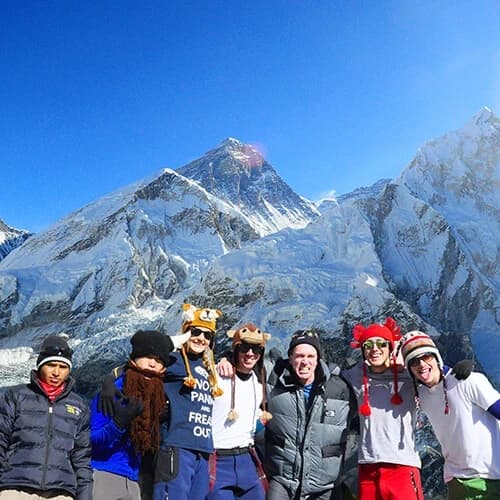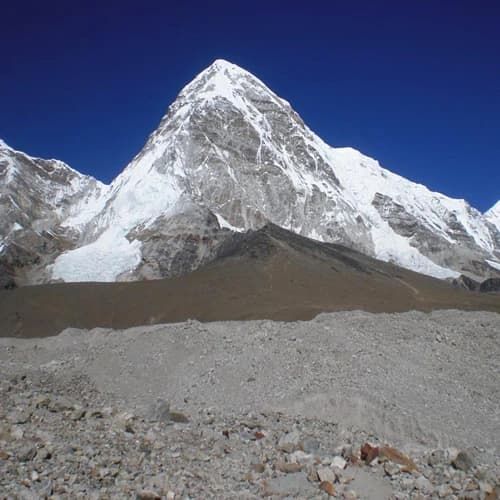The Everest Base Camp Trek is one of the best high-altitude expeditions in the world. This iconic trail is the dream adventure for trekkers and adventurers worldwide. While most trekkers conquer their Everest dream, their challenges hold some unlucky individuals back. One of those challenges is the Everest base camp trek elevation gain. The Base Camp is 5,364 m (17,598 ft) above sea level, which can be challenging for people with no prior hike experience to reach. Lukla is the starting point of the trek, from where you will pass through the alpine forest and icy landscape of the Khumbu region. The elevation gain can be challenging during the journey. However, it can be tackled with proper information about the expedition and adequate preparation. This blog details the Everest Base Camp trek elevation gain to prepare you for your dream adventure.
Everest Base Camp Trekking Elevation Gain
Understanding Elevation Gain Along the Route
Elevation gain is essential to the trekker’s journey and demands thorough preparation and understanding. The trekking distance from Lukla to Everest Base Camp is around 65 kilometers (40 miles), with an elevation difference of 2504 meters or 8,215 ft. Therefore, it is essential to understand the challenges and prepare accordingly.
Elevation gain during the Everest Base Camp Trek
The Everest Base Camp trek is a rollercoaster traversing various elevations. Elevation gain (altitude gain) refers to the vertical distance you ascend during the trek. In other words, it's the difference in altitude from where you start to where you end up at the top. Understanding elevation gain is essential for a successful and satisfactory experience.
In this section, we delve into the elevation profile of the Everest Base Camp trek and critical landmarks. This information helps you understand what to expect daily during your trek and prepare accordingly.
Kathmandu to Lukla
Kathmandu is the starting point of the journey to Everest Base Camp. You fly to Lukla, the gateway to Everest, from Kathmandu and enjoy the scenic beauty. Due to the geographical obstacles and high altitude, Lukla Airport is considered one of the most adventurous airports in the world.
Lukla to Phakding
After reaching Lukla, your trek to the Everest Base Camp officially begins. Lukla is situated at 2,840 m (9,317 ft) above sea level, a new experience for most novice trekkers. So, get ready for a true trekking adventure. The initial leg of the trek begins with a short descent to Phakding at 2,610 m (8,563 ft), allowing the trekkers to get into the rhythm of the trek. You will trek alongside the Dudh Koshi River, enjoying the diverse landscape of Sagarmatha National Park. The final ascent of this section resumes from Ghat, finally reaching Phakding with an elevation loss of 230 meters.
Phakding to Namche Bazaar
After reaching Phakding at an elevation of 2,610 meters, your trek heads toward the busy Namche Bazar. You will continue your trek along the Dudh Koshi River, crossing a series of exciting suspension bridges, including the Hillary Bridge. After 3 hours of ascent through villages like Monjo and Larja, you reach Namche Bazar at 3,440 m (11,286 ft) of elevation. You will achieve an elevation gain of around 800 meters by now. Due to the significant elevation gain, you must rest and acclimate properly. So, the next day, you will spend the entire day exploring Namche and experiencing the vibrant Sherpa culture. Besides that, we will hike to Hotel Everest View, which stands at an elevation of 3,880 m (12,729 ft). The short tour will prepare your body for the next day's long hike.
Namche Bazaar to Tengboche
After acclimating at Namche Bazaar (3,440 m), you will ascend towards Tengboche. This trail ahead leads you to Kenjoma, from where you will gently descend to Phunke Tenga alongside vibrant rhododendron forests. After ascent of 420 meters, you will reach the beautiful village of Tengboche at 3,860 m (12,664 ft). Tengboche is famous for its monastery, one of the region's largest. Here, you can relax in the spiritual respite and enjoy the view of Mount Everest, Lhotse, and Ama Dablam.
Tengboche to Dingboche
When you move towards Dingboche, the trail becomes wide and offers views of the beautiful valleys of the Khumbu region. The trek begins with a gentle descent towards Pangboche, crossing a thrilling suspension bridge over a gushing river. Eventually, you gradually descend to Somare through thick vegetation. Moving ahead, you will hike on rugged and barren landscapes until you reach Dingboche at 4,410 m (14,468 ft).
After completing the trek, you will achieve an elevation gain of 550 meters from Tengboche to Dingboche. This significant gain also makes Dingboche a crucial acclimatization point on the Everest Base Camp trek. On the rest day, you can help your body acclimatize by hiking to Nangkartshang Peak at 5,083 m (16,676 ft). You must ascend slowly, as you will cover more than 600 meters of elevation during the hike.
At the summit, you will marvel at the majestic views of Nuptse (7,861m), Lhotse (8,516m), Cho Oyu (8,188m), Makalu (8,481m), and many other mountain peaks.
Dingboche to Lobuche
The segment from Dingboche to Lobuche brings you closer to the Khumbu region's Himalayas. Today's hike begins with a gradual ascent alongside the Khumbu Khola, which leads you to the Thukla Pass at 4,830 m (15,846 ft). Thukla Pass features many memorials to those who have died on Everest; here, you pay respect to those who have lost their lives and pray for their departed soul. Eventually, you will reach Lobuche at 4,910 m (16,109 ft), where you can glimpse the Khumbu glacier. The total elevation gain from Dingboche to Lobuche is 500 meters. Here, you can enjoy a relaxing evening with the majestic views of Nuptse, Pumoru, Changri, and Lho La.
Lobuche to Gorakshep and Everest Base Camp
The final leg of the Everest Base Camp trek begins from Lobuch. You will ascend to Gorkshep at 5,140 m (16,863 ft), with an elevation gain of 230 meters from Lobuche. The challenging hike ahead will be the ultimate test of your endurance and stamina. You can enjoy majestic views of the Khumbu Glacier and Khumbu Icefall at Gorakshep. From Gorakshep, you will walk on an uneven rocky trail and icy landscape until you arrive at the Everest Base Camp at 5,364 m (17,598 ft). The total elevation gain for this section is 454 meters. The magical experience evokes a sense of achievement as you stand at the base of the world's tallest mountain. From the EBC, you will witness spectacular views of the snowy landscape. After this majestic experience, you return to Gorakshep and spend the night there.
Gorakshep to Kala Patthar
If you're looking for an extra adventure on your Everest Base Camp trek, the hike from Gorakshep to Kalapathhar is perfect. The challenging hike takes you to one of Nepal's most famous vantage points, which stands at a higher elevation than Everest Base Camp. Starting from Gorakshep, you'll hike on a rocky trail and achieve an elevation gain of 415 meters to reach Kalapathhar at 5,555 meters (18,225 feet). From here, you get magnificent views of the surrounding mountain peaks. After enjoying the view, you’ll head back down to Pheriche. This means losing significant altitude on your hike back.
Effects of Altitude on the Body
Air pressure and oxygen levels decrease when you make your way to the high-altitude area of the Khumbu region. The elevation gains can cause oxygen levels to decrease, which leads to hypoxia. The atmospheric changes can also cause altitude sickness, also known as acute mountain sickness. Altitude sickness features a range of symptoms, including difficulty breathing, headache, fatigue, nausea, dizziness, loss of appetite, and an increased heart rate. The elevation gain can also cause altitude-related illnesses, such as High Altitude Pulmonary Edema (HAPE) and High Altitude Cerebral Edema (HACE). These conditions start with a mild effect, but with elevation gain, it becomes worse and even life-threatening if proper preventive measures are not taken.
Acclimatization Strategies
Acclimatization is the process that helps your body adjust to the low oxygen levels at higher altitudes. All trekkers on the Everest Base Camp (EBC) trek need to rest and allow their bodies to acclimatize. Here are some simple tips to help your body acclimatize:
- Hike gradually to allow your body time to adjust to the changing elevation. Your EBC trek plan will have 2-3 days for rest and acclimatization.
- Go on short hikes during the rest days to allow your body to prepare itself for the steep ascend in the coming days.
- Drink plenty of water to stay hydrated. Eat a balanced diet with high-protein snacks and avoid caffeine and alcohol.
- Walk at a steady pace, and don't push yourself too hard. If necessary, take extra days to rest.
- Being fit and having good cardiovascular health helps immensely, as you won't burn yourself out on the trail.
- If you don't feel well, rest at the tea house. Only continue the trek when you feel healthy and in good condition.
- Following these simple steps, you can have a safe and enjoyable trek to Everest Base Camp.
Preparation for Everest Base Camp Elevation Gain
- Start physical training three months before the trek. Follow an exercise program focusing on cardiovascular health, endurance, and stamina. Indulge yourself in activities like swimming, cycling, and running.
- Go on shorter hikes prior to the EBC trek to train yourself to adjust to the high-altitude regions. This will allow your body to experience similar challenges you might face ahead.
- Study and keep yourself informed about the symptoms of altitude sickness. Learn useful tips to prevent it and its early symptoms.
- In your packing list for the EBC Trek, include suitable gear and accessories, such as study boots, trekking poles, and knee support, to avoid any further challenges with the elevation.
Some Most Popular Treks
- Everest Base Camp Trek - 14 Days
- 12 Days Everest Base Camp Trek
- Everest Base Camp Luxury - 14 Days
- Everest Cho La Pass - 17 Days
- Everest High Pass 16 - Days
- Annapurna Base Camp - 13 Days
- Ghorepani Poon Hill - 7 Days
- Annapurna Circuit - 17 Days
- 12 Days Annapurna Circuit Trek
- Manaslu Circuit - 14 Days
- Manaslu Trek 12 Days
- Everest Base Camp with Island Peak - 16 Days
- Everest Luxury Trek with Helicopter Return
- Langtang Valley - 10 Days



